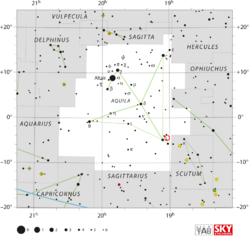Astronomy:V604 Aquilae
| Observation data Equinox J2000.0]] (ICRS) | |
|---|---|
| Constellation | Aquila |
| Right ascension | 19h 02m 06.33s[2] |
| Declination | −04° 26′ 43.2″[2] |
| Apparent magnitude (V) | 7.6(blue) – 19.6(V)[3] |
| Astrometry | |
| Absolute magnitude (MV) | -8.3[4] |
| Characteristics | |
| Spectral type | pec(Nova)[3] |
| B−V color index | 0.3[5] |
| Variable type | NA[3] |
| Other designations | |
Nova Aquilae 1905, CSI-04-18594, SV* HV 1175, AAVSO 1856-04, AN 104.1905, HD 176779. | |
| Database references | |
| SIMBAD | data |
V604 Aquilae or Nova Aquilae 1905 is a nova which was first observed in the constellation Aquila in 1905 with a maximum brightness of magnitude 7.6.[3] It was never bright enough to be seen with the naked eye. It was discovered by Williamina Fleming on a Harvard College Observatory photographic plate taken on August 31, 1905.[6] Examination of plates taken earlier indicates that peak brightness occurred in mid-August 1905.[7] The star's quiescent visual band brightness is 19.6.[5]
V604 Aquilae faded by 3 magnitudes in just 25 days, making it a "fast nova".[6] Detection of a faint nebula surrounding the star, with a radius of 0.4 arc minutes, was reported early in 1906.[8] In 1994, a photometric study detected brightness variations of up to ~0.45 magnitudes on timescales of about one hour.[9] An attempt to detect cool molecular gas surrounding the nova in 2015 was unsuccessful.[10]
References
- ↑ Walker, Arville D. (1933). "The photographic light curves of thirteen novae". Annals of the Astronomical Observatory of Harvard College 84 (7): 764. doi:10.1086/320802. Bibcode: 2001PASP..113..764D. https://articles.adsabs.harvard.edu/pdf/1933AnHar..84..189W. Retrieved 27 October 2022.
- ↑ 2.0 2.1 Downes, Ronald A.; Webbink, Ronald F.; Shara, Michael M.; Ritter, Hans; Kolb, Ulrich; Duerbeck, Hilmar W. (June 2001). "A Catalog and Atlas of Cataclysmic Variables: The Living Edition". The Publications of the Astronomical Society of the Pacific 113 (784): 764–768. doi:10.1086/320802. Bibcode: 2001PASP..113..764D. https://iopscience.iop.org/article/10.1086/320802. Retrieved 27 October 2022.
- ↑ 3.0 3.1 3.2 3.3 "V0604 Aql". AAVSO. https://www.aavso.org/vsx/index.php?view=detail.top&oid=1743.
- ↑ Harrison, T. E. (February 1991). "IRAS Observations of Classical Novae. II. Modeling the Detections". Astronomical Journal 101: 587. doi:10.1086/115708. Bibcode: 1991AJ....101..587H. https://ui.adsabs.harvard.edu/abs/1991AJ....101..587H. Retrieved 28 October 2022.
- ↑ 5.0 5.1 Szkody, Paula (August 1994). "BVRGK Observations of Northern Hemisphere Old Novae". Astronomical Journal 108: 639. doi:10.1086/117098. Bibcode: 1994AJ....108..639S. https://ui.adsabs.harvard.edu/abs/1994AJ....108..639S. Retrieved 28 October 2022.
- ↑ 6.0 6.1 Duerbeck, Hilmar W. (March 1987). "A Reference Catalogue and Atlas of Galactic Novae". Space Science Reviews 45 (1–2): 1–14. doi:10.1007/BF00187826. Bibcode: 1987SSRv...45....1D. https://articles.adsabs.harvard.edu/pdf/1987SSRv...45....1D. Retrieved 27 October 2022.
- ↑ Tappert, C.; Vogt, N.; Della Valle, M.; Schmidtobreick, L.; Ederoclite, A. (July 2014). "Life after eruption - IV. Spectroscopy of 13 old novae". Monthly Notices of the Royal Astronomical Society 442 (1): 565–576. doi:10.1093/mnras/stu781. Bibcode: 2004IBVS.5550....1H. https://ui.adsabs.harvard.edu/abs/2014MNRAS.442..565T. Retrieved 28 October 2022.
- ↑ Pickering, Edward C. (January 1906). "Nova 104.1905 Aquilae". Astronomische Nachrichten 170 (9): 147. doi:10.1002/asna.19051700913. Bibcode: 1906AN....170..147P. https://articles.adsabs.harvard.edu/pdf/1906AN....170..147P. Retrieved 27 October 2022.
- ↑ Haefner, R. (August 2004). "CCD Photometry of Five Faint Cataclysmic Variables". Information Bulletin on Variable Stars 5550: 1. Bibcode: 2004IBVS.5550....1H. https://ui.adsabs.harvard.edu/abs/2004IBVS.5550....1H. Retrieved 28 October 2022.
- ↑ Kamiński, Tomek; Mazurek, Helena J.; Menten, Karl M.; Tylenda, Romuald (March 2022). "A search for cool molecular gas in GK Persei and other classical novae". Astronomy and Astrophysics 659: A109. doi:10.1051/0004-6361/202142737. Bibcode: 2022A&A...659A.109K. https://www.aanda.org/articles/aa/full_html/2022/03/aa42737-21/aa42737-21.html. Retrieved 28 October 2022.
External links
 |



